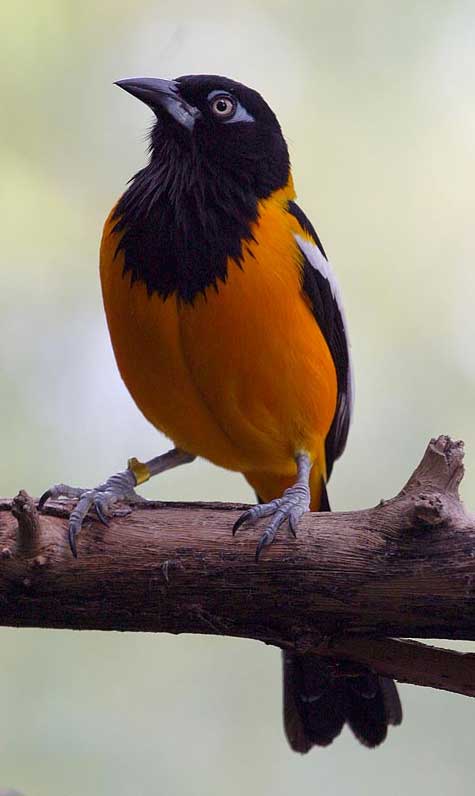Icterus icterus (*) Cladus: Eukaryota Subspecies: I. i. icterus - I. i. metae - I. i. ridgwayi Name Icterus icterus (Linnaeus, 1766) Vernacular names Reference Syst. Nat. ed.12 p.161 The Troupial (Turpial in Spanish), Icterus icterus is the national bird of Venezuela and one of about 25 or so species of "New World Orioles". It is found across South America east of the Andes, from Colombia, Venezuela and the Guianas down to Argentina. This bird can also found on Aruba, Bonaire Puerto Rico and Curaçao. Description Troupials are fairly large in size, with a long tail and a bulky bill. It has a black head and upper breast. The feathers on the front of the neck and upper breast stick outward, making an uneven boundary between the black and the orange of the bird's lower breast and underside. The rest of the orange color is found on the upper and lower back, separated by the black shoulders. The wings are mostly black except for a white streak that runs the length of the wing when in a closed position. The eyes are yellow, and surrounding each one, there is a patch of bright, blue, naked skin. In addition to the description above, there are four subspecies (I. i. metae, I. i. ridgwayi, I. i. croconotus and I. i. jamacaii). Individuals of I. i. metae have more orange on the back and a black line that divides the lengthwise white wing-stripe in half. Individuals of I. i. ridgwayi are generally stronger and larger in proportion to the other subspecies. Sometimes I. croconotus, with ridgwayi, and I. jamacaii, with metae, are considered separate species (Orange-backed Troupial and Campo Troupial, respectively). In that case, I. icterus is called the Venezuelan Troupial. Troupials inhabit dry areas like woodlands, gallery forest, dry scrub, llanos and open savannah where they forage for insects, a wide variety of fruit, small birds and eggs. Generally they can be found in central South America with some of the subspecies to the northern and eastern extremes of the continent. Venezuelan Troupials breed from March to September. They do not construct their own nests, but are instead obligate nest pirates. This means that they make no nest of their own, but instead must either find a vacant nest, or must drive the adults away from an active nest. Venezuelan Troupials are capable of violent attacks against established nesters. Upon taking over a nest, they may eat any eggs or young nestlings remaining the newly acquired nest, and will fiercely defend the area against would-be intruders. Eventually the adult Troupials go on to produce their own clutch of 3 to 4 eggs that hatch after about two weeks of incubation. BirdLife International (2004). Icterus icterus. 2006. IUCN Red List of Threatened Species. IUCN 2006. www.iucnredlist.org. Retrieved on 12 May 2006. Database entry includes justification for why this species is of least concern
Source: Wikipedia, Wikispecies: All text is available under the terms of the GNU Free Documentation License |
|

